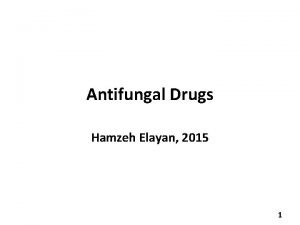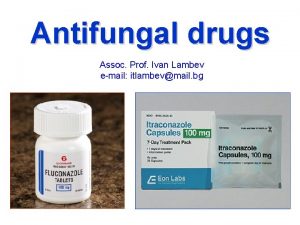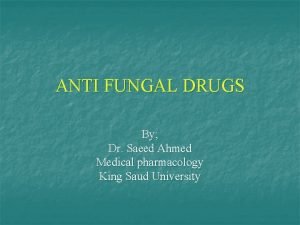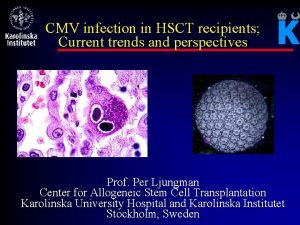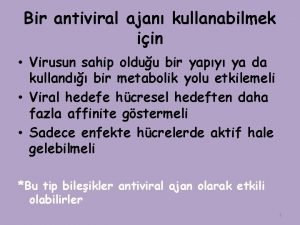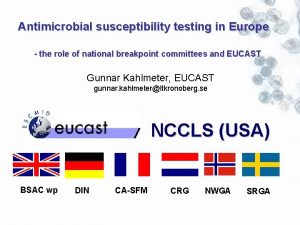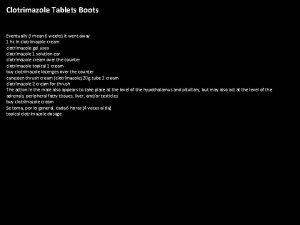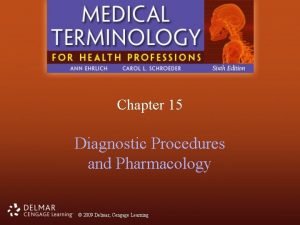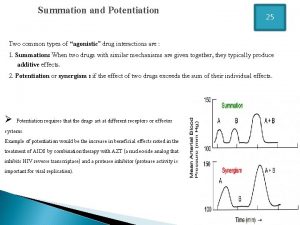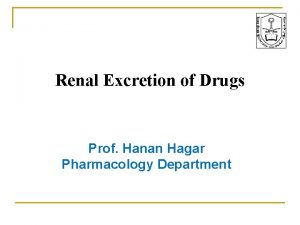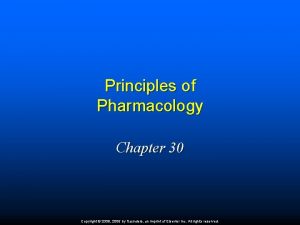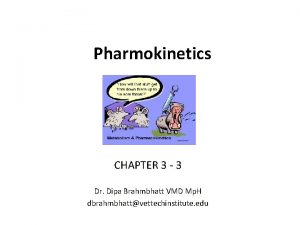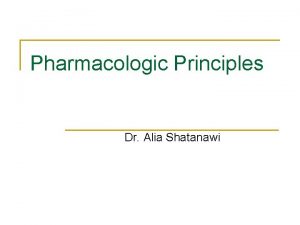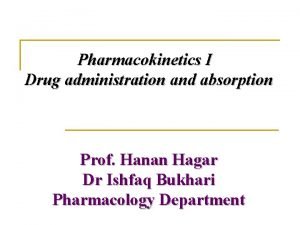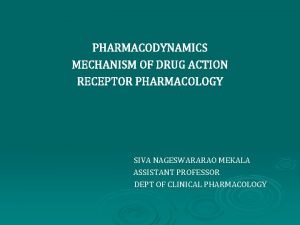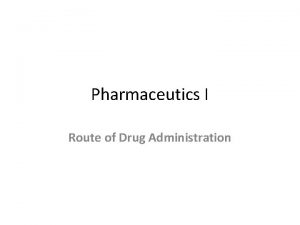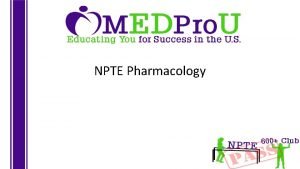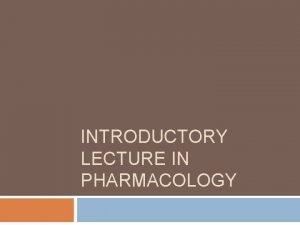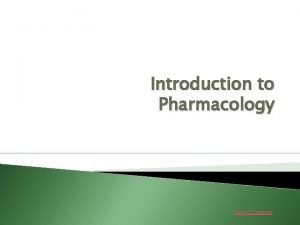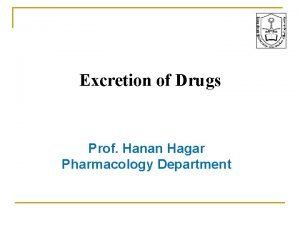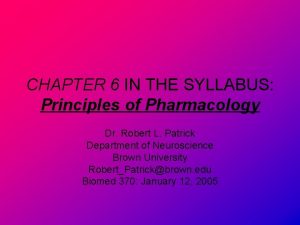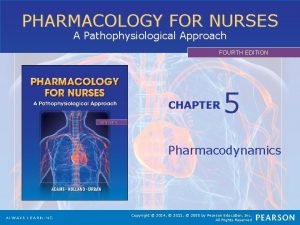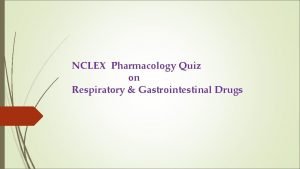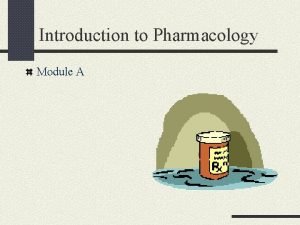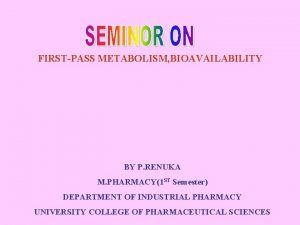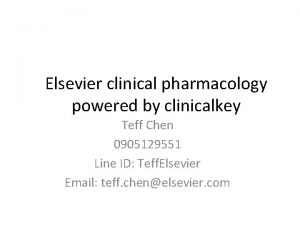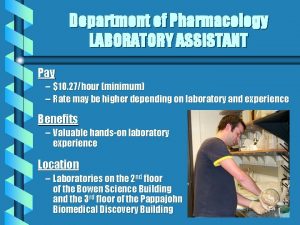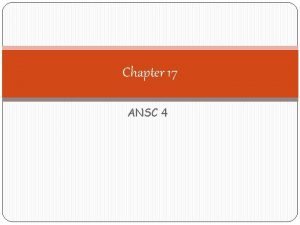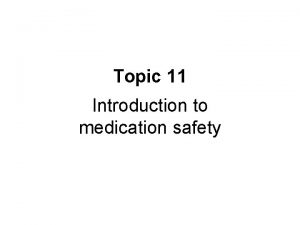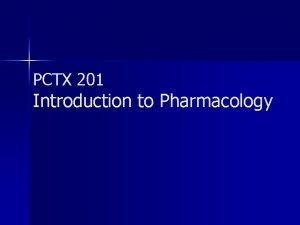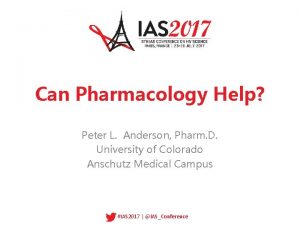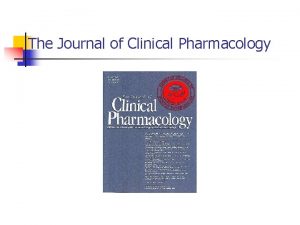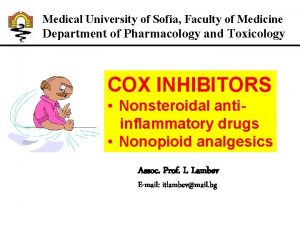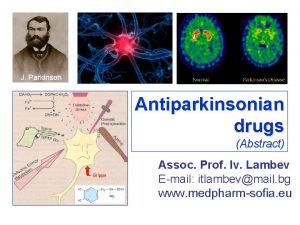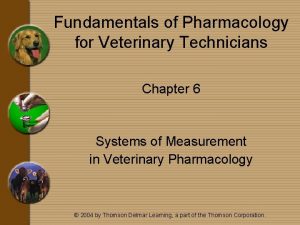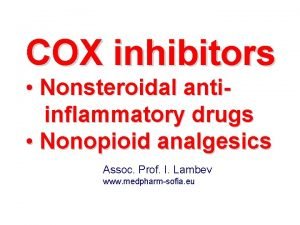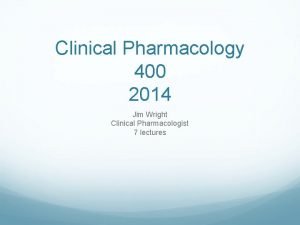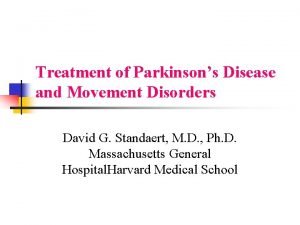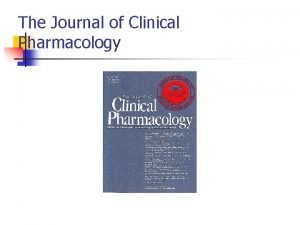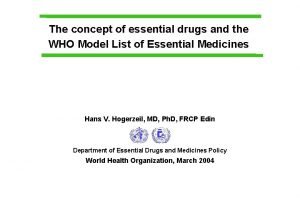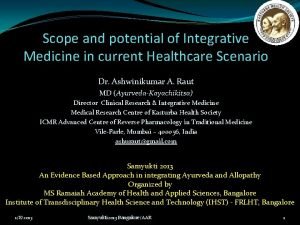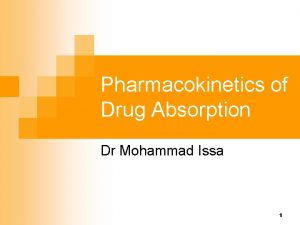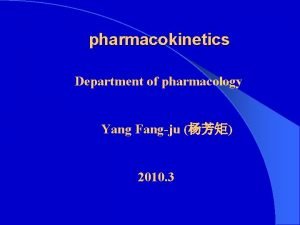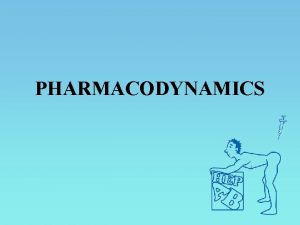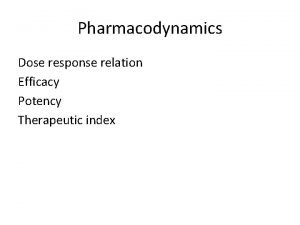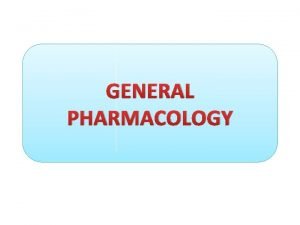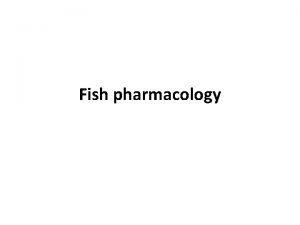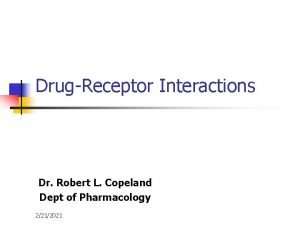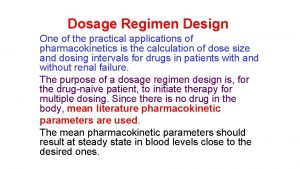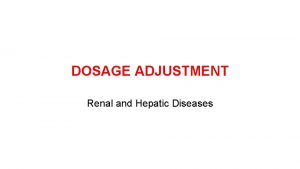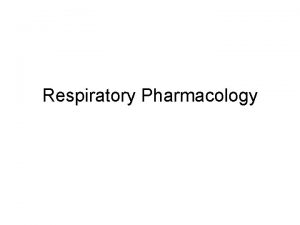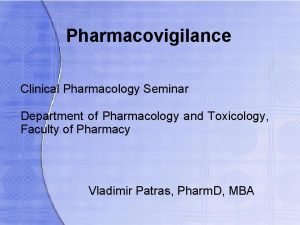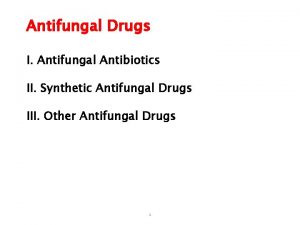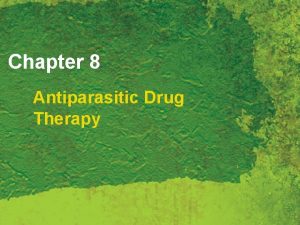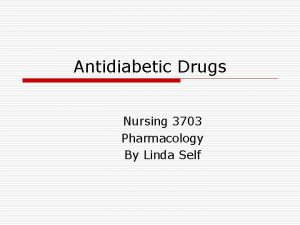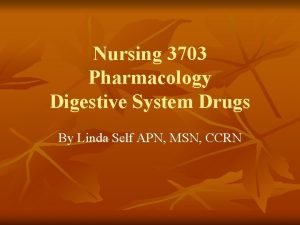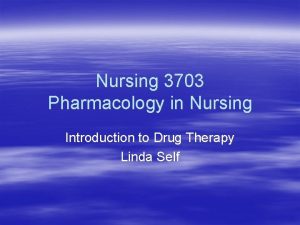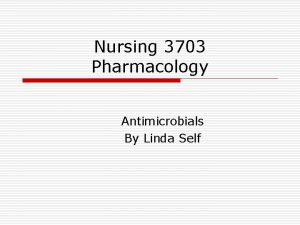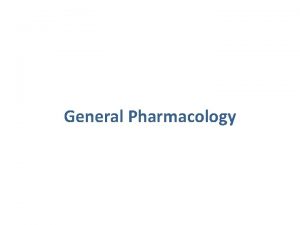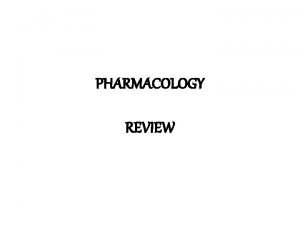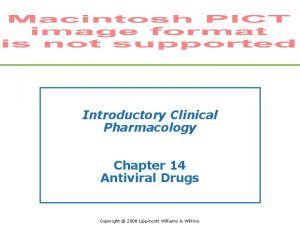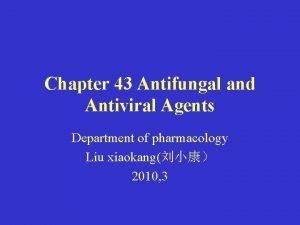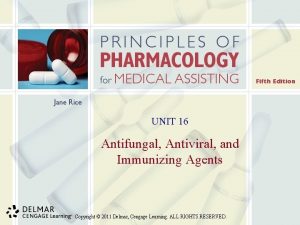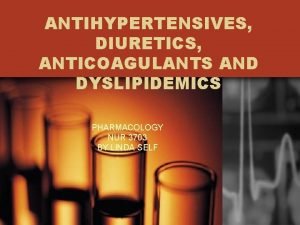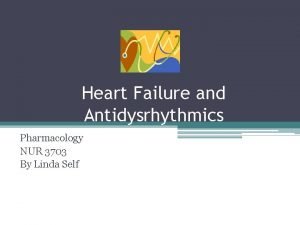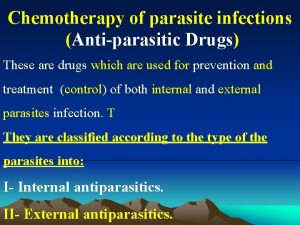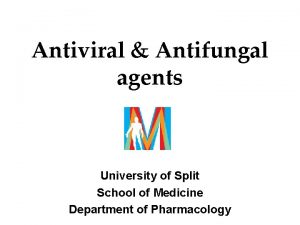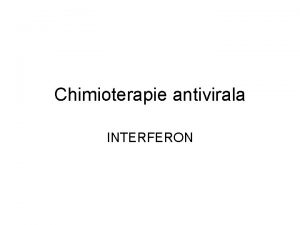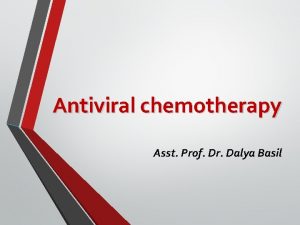Antiviral Antifungal and Antiparasitic Drugs Nursing 3703 Pharmacology































































- Slides: 63

Antiviral, Antifungal and Antiparasitic Drugs Nursing 3703 Pharmacology By Linda Self

Viruses • Intracellular parasites • Enter host, bind to receptors on cell membranes • Use cellular metabolic activities for replication • May be DNA or RNA viruses

Viruses • DNA viruses incorporate into chromosomal DNA, produce new viruses • RNA viruses must be converted to DNA by reverse transcriptase in order to replicate

Viruses • Induce antibodies and immunity • Protein coat allows host recognition as foreign vs. self • Exception is influenza

Viral illnesses • • • Herpes Simplex 1 and 2 Cytomegalovirus Influenza RSV Rotavirus HIV and AIDS

Antiviral Drugs • Catalyst was AIDS • Both for Tx of AIDS and for opportunistic infections

Viral Vaccines • • • Poliomyelitis Measles Rubella Varicella RSV HPV Herpes Zoster Yellow Fever others

Viral Vaccines • Attenuated vaccines generally safe • Do not use in patients who are: pregnant, on steroids, receiving immunosuppressants or antineoplastiacs, undergoing radiation Tx or who are immunodeficient

Drugs for Herpes Virus Infections • Zovirax (acyclovir) for herpes labialis, varicella, herpes zoster, genital herpes • Famvir (famciclovir) for zoster and genital herpes • Valtrex (valacyclovir) for herpes labialis, zoster, recurrent genital herpes • Famvir and Valtrex need titration in renally impaired

Influenza H=hemagglutinin N=neuramidase April 2009 Quadruple reassortment Tx—Tamiflu (oseltamivir) or Relenza (zanamivir) or Flumadine (rimantadine) • Tx for 5 days • Relenza can cause bronchospasm • • •

Influenza • To short course of infection, must be started within 48 h • Thereafter, ? may decrease severity

RSV • Virazole (ribavirin) • Administered by inhalation • Can cause bronchospasm

Viral hepatitis • Hepatitis B—Hepsera (adefovir), Epivir (lamivudine) • Hepatitis C—peginterferon alfa 2 a and Virazole (ribavirin)

HIV • Unique features • 2 proteins on surface of virus bind with 2 sites on CD 4+ cell • Virus infiltrates into genetic material • Reverse transcriptase enzyme enables virus to become double stranded DNA

HIV • Once double-stranded DNA, like the host cell, HIV can infiltrate cell nucleus of target cell • Gains entry into target cell nucleus with aid of Integrase • Following integration and replication, long protein chain is cleaved. Pieces then form into new viral particle

HIV • Cleavage is accomplished with aid of protease • See page 568

Drugs for HIV Infection • Nucleoside reverse transcriptase inhibitors • Nucleotide reverse transcriptase inhibitors • Non-nucleoside reverse transcriptase inhibitors • Protease inhibitors • Entry inhibitors

Antiretrovirals • Always used in combination • Target enzymes or receptor sites • Specific guidelines for pregnancy

Nucleoside Reverse Transcriptase Inhibitors • Prototype is AZT • Similar structurally to DNA components (adenosine, guanosine, cytosine or thymidine) • Affect thymidine, thus inhibit reverse transcriptase • Slow progression but do not cure • Didanosine, Ziagen (abacavir), AZT (zidovudine), Epivir (lamivudine)

Nucleotide Reverse Transcriptase Inhibitors • Also inhibit reverse transcriptase • Differ structurally from nucleoside RTI so circumvent resistance • Viread (tenofovir) • Used to Tx hep B as well

Non-nucleoside Reverse Transcriptase Inhibitors • Directly bind with reverse transcriptase • Used in combination with NRTIs • Viramune (nevirapine) and Sustiva (efavirenz)

Protease Inhibitors • Inhibit action of protease • Most protease inhibitors metabolized by cytochrome p 450 system • Many drug interactions • Liver toxicities • Lipid abnormalities • Hyperglycemia • lipodystrophies

Protease Inhibitors • Prezista (darunavir), Crixivan (indinavir), Viracept (nelfinavir), Norvir (ritonavir), Invirase (saquinavir)

Combination Antiretrovirals • Combovir (stavudine and zidovudine) • Trizivir (abacavir, lamivudine and zidovudine) • Decrease pill burden

Entry Inhibitors • Fuzeon (enfuvirtide) • Selzentry (maraviroc) • Do not act on enzymes but rather affect glycoproteins that allow binding and fusion of the virus to the CD 4+ cell

Integrase inhibitors • Still in clinical trials

Fungi (mycoses) • Mild or life threatening • Widely present in environment • Dermatophytes—tinea capitis, tinea pedis, tinea cruris, tinea corporis • Examples: Candida, Aspergillosis, Cryptococcus, Histoplasmosis, B

Antifungal Drugs • Development of antifungals difficult because fungal cells closely resemble human cells • Polyenes—Amphotericin B, Nystatin • Azoles—Sporonox (itraconazole), Nizoral (ketoconazole), Diflucan (fluconazole) • Echinocandins—Eraxis (anidulafungin), Cancidas (caspofungin)

Fungizone (amphotericin B) • Give in D 5 W • Use separate line • In line filter depending on formulation • Adverse effects: Infusion reaction with chills, fever, tachypnea Treat with Benadryl, Tylenol or steroids • Nephrotoxicity most serious SE

Amphotericin B • Indicated for life-threatening fungal infections such as aspergillosis, blastomycosis, candidiasis, coccinioidomycosis, crytococcis and histoplasmosis • Drug concentrations are highest in inflamed tissues

Miscellaneous Antifungals • Lamisil (terbinafine) • griseofulvin

Mycostatin (nystatin) • Same mechanism of action as Amphotericin B • Too toxic for systemic use

Azoles • • Largest group of commonly used antifungals Can be used topically or systemically Prototype is Nizoral (ketoconazole 0 All azoles are contraindicated in pregnancy

Azoles • • • Less toxic than ampho Many drug interactions Poor absorption if achlorhydric Some hepatotoxicity Can be given orally

Diflucan (fluconazole) • Synthetic, broad spectrum against candidiasis, cryptococcis, coccidioidomycosis • Not effective against aspergillosis • PO or IV • Fewer side effects than ketoconazole • Does not require gastric acidity, does not cross blood-brain barrier • Reduce dosage in renal failure

Sporanox (itraconazole) • Similar to Diflucan • Drug of choice for blastomycosis, histoplasmosis and sporotrichosis • Good for suppressive Tx in AIDS patients w/histo • Contraindicated for dermatophytic infections and onychomycoses in heart failure patients • IV or PO • Many drug interactions

Cancidas (caspofungin) • First chicocandin antifungal • Affects glucan in fungal cell wall leading to leakage of cellular contents • Indicated for Tx of invasive aspergillosis who cannot take or do not respond to Fungizone or Sporanox

Cancidas • • • Can cause thrombophlebitis Abnormalities in blood count Liver impairment Drug interactions Mix only with normal saline, infuse over at least one hour

Fulvicin (griseofulvin) • For dermatophyte infections of the scalp and nails and for extensive skin eruptions • Drug binds to keratin, over time the infected tissues are shed and replaced by uninfected tissues • Need 3 -8 weeks to Tx ringworm • Up to one year for onychomycoses

Fulvicin • Side effects: GI upset, skin rash, insomnia, fatigue, hepatotoxicity, blood dyscrasias and peripheral neuritis • Take with fatty meal • May affect efficacy of OCP • Coumadin may warrant adjustment

Lamisil (terbinafine) • Synthetic with broad spectrum of activity • Inhibits an enzyme needed for synthesis of ergosterol, a structural component of fungal cell membranes • Good for Tx of ringworm, nails • hepatotoxic

Drug Treatment for Specific Infections • Aspergillosis—Sporonox, Amphotericin B • Blastomycosis—Sporonox, Amphotericin B • Candidiasis—varies r/t area of infection Oral Cutaneous Vaginal Systemic

Drug Treatment for Fungal Infections • • Histoplasmosis—Sporanox PCP—Bactrim, pentamidine, dapsone, others Cryptococcis-Amphotericin B Coccidioidomycosis- azole to Amphotericin B

Aspergillosis • Found in soil, decaying plant matter, cellars • May be found in cereals, powdered milk, peanuts, cashews, coffee beans • Characterized by granulomatous lesions of lungs, skin, eyes, nose, urethra and may infiltrate to vital organs • Occurs in debilitated and immunocompromised • Tx w/ Amphotericin or Sporonox

Histoplasmosis • Found in soil, organic debris around chicken houses, bird roosts and caves inhabited by bats • Develops when spores are inhaled • Tx with Sporanox, possibly Ampho

Candidiasis • Yeast infection commonly affects those on abx therapy, inhaled steroids, diabetics, those on antineoplastic Tx or on steroids or who have AIDS • Presents as: vaginal candidiasis, skin candidiasis, oral candidiasis or systemic disease

Tx for Candidiasis • Systemically—Amphotericin B • Vaginally-Lotrimin (clotrimazole), Diflucan • Oropharyngeal, esophageal, vaginal and systemic—Diflucan PO or IV

Parasites • Organisms that live within, upon or at expense of another organism to survive • Include protozoa, helminths, scabies and pediculi

Protozoa • Include amebiasis, giardiasis, malaria, toxoplasmosis and trichomoniasis • Single celled, may be saprophytes. Usually contracted by oral-fecal route, by contaminated water or by bite of an insect.

Amebiasis • Common in Africa, Asia and Latin America • In US, more likely in homosexuals and bisexual men and in those who travel to areas with poor sanitation

Amebiasis • Drugs used are classified according to site of action • Extraintestinal e. g. liver—use Aralen (chloroquine) • For Intestinal use Yodoxin (lodoquinol) • Flagyl is effective for intestinal and extraintestinal amebiasis • May also use tetracycline or doxycycline as they alter bacterial flora

Giardiasis • Caused by Giardia lamblia • Spread by food or water contaminated with feces with encysted forms of organism • Also can contract by person to person transmission in day cares, institutions and in homosexual or bisexual men

Giardiasis • Seen in campers who drink water • Causes diarrhea • Can progress to chronic condition with malabsorption, wt. loss, anorexia • Can result in B 12 deficiency • Tx is Flagyl

Malaria • Seen in tropics • Rare in US • Caused by four species of protozoa of genus Plasmodium-vivax, malariae, ovale and falciparum • Transmitted by the Anopholes mosquito • Antimalarials act at different stages in life cycle

Malaria • Chloroquine with primaquine is used for prophylaxis • Lariam (mefloquine) for prevention and Tx, better in more resistant forms • Plaquenil (hydroxychloroquine) used to Tx erythrocytic malaria • Daraprim (pyrimethamine) folic acid antagonist also used in prevention

Malaria • • Quinamm (quinine) prototype Derived from bark of cinchona tree Sometimes still used for leg cramps Replaced by agents with fewer SE

Trichomoniasis • Vaginal infection caused by Trichomonas vaginalis • Contracted sexually • Treat both partners • Flagyl is Tx

Helminthiasis • Infestation with parasitic worms • Some types of worms penetrate body tissues or produce larvae that migrate to blood, lymph, lungs, liver or other sites • Some anthelminthics act locally, some systemically

Vermox (mebendazole) • Effective for hookworms, pinworms, roundworms, whipworms • May be useful with tapeworms • Prevents uptake of glucose necessary for parasitic metabolism • Only 10% is absorbed systemically

Stromectrol (vermectin) • Used for various parasitic infections, most useful in stronguloidiasis • Also used for resistant lice

Scabies and Pediculosis • Parasitic infestations of the skin • Scabies by the itch mite called the Sarcoptes scabeii • Scabies caused by one of three types of lice: pediculosis capitis, pediculosis corporis and pediculosis pubis

Scabicides and Pediculocides • • • Permethrins drug of choice for both Two applications recommended Pediculosis is a 1% preparation (Nix) Scabies used a 5% cream (Elimite) Permethrins safest Second line use Lindane (gamma benzene hexachloride)

Scabicides and Pediculosis • Ovide (malathion) is a pediculicide for head lice • Rid (pyrethrin) for pediculosis
 Classification of antifungal drugs
Classification of antifungal drugs Mechanism of action of antifungal drugs
Mechanism of action of antifungal drugs Nystatin nursing implications
Nystatin nursing implications Antifungal drugs classification
Antifungal drugs classification Second antiviral pill
Second antiviral pill Idoksüridin
Idoksüridin Pharmacology of drugs acting on respiratory system
Pharmacology of drugs acting on respiratory system Adrenal drugs pharmacology
Adrenal drugs pharmacology Antifungal sensitivity test
Antifungal sensitivity test Nystatin uk boots
Nystatin uk boots Pharmacology and venipuncture
Pharmacology and venipuncture Chapter 15 diagnostic procedures and pharmacology
Chapter 15 diagnostic procedures and pharmacology Toxicology and applied pharmacology
Toxicology and applied pharmacology Annual review of pharmacology and toxicology
Annual review of pharmacology and toxicology Potentiation pharmacology example
Potentiation pharmacology example Prostagalndins
Prostagalndins What is ion trapping in pharmacology
What is ion trapping in pharmacology Enzyme inducer drugs
Enzyme inducer drugs Chapter 30 principles of pharmacology
Chapter 30 principles of pharmacology First pass metabolism
First pass metabolism Alia drug testing
Alia drug testing What is pharmacology
What is pharmacology Advantages and disadvantages of drugs
Advantages and disadvantages of drugs Mechanism of drug action
Mechanism of drug action First pass effect
First pass effect Basic principles of pharmacology
Basic principles of pharmacology What is pharmacology
What is pharmacology Slidetodoc.com
Slidetodoc.com Therapeutic index
Therapeutic index What is ion trapping in pharmacology
What is ion trapping in pharmacology Basic principles of pharmacology
Basic principles of pharmacology Pharmacology for nurses: a pathophysiological approach
Pharmacology for nurses: a pathophysiological approach Respiratory pharmacology quiz
Respiratory pharmacology quiz Pharmacology module
Pharmacology module First pass metabolism definition pharmacology
First pass metabolism definition pharmacology Clinical pharmacology powered by clinicalkey
Clinical pharmacology powered by clinicalkey Pharmacology pay
Pharmacology pay Pharmacology definition
Pharmacology definition Rationale meaning in pharmacology
Rationale meaning in pharmacology Pharmacology chapter 1
Pharmacology chapter 1 Pharmacology tutor anderson
Pharmacology tutor anderson Clinical pharmacology
Clinical pharmacology Basic & clinical pharmacology
Basic & clinical pharmacology Basic & clinical pharmacology
Basic & clinical pharmacology Objectives of pharmacology
Objectives of pharmacology Fundamentals of pharmacology for veterinary technicians
Fundamentals of pharmacology for veterinary technicians Chronic gout
Chronic gout Clinical pharmacology residency
Clinical pharmacology residency Dopamine pharmacology
Dopamine pharmacology Define pharmacology
Define pharmacology Concept of essential drugs
Concept of essential drugs Reductinist
Reductinist Filtration pharmacology
Filtration pharmacology Loading dose
Loading dose Bioavailability definition
Bioavailability definition Tachyphylaxis in pharmacology
Tachyphylaxis in pharmacology Efficacy definition pharmacology
Efficacy definition pharmacology Large volume of distribution drugs
Large volume of distribution drugs Fish pharmacology
Fish pharmacology Pharmacology definition
Pharmacology definition Loading dose calculation example
Loading dose calculation example Maintenance dose formula
Maintenance dose formula Mdi pharmacology
Mdi pharmacology Clinical pharmacology seminar
Clinical pharmacology seminar
